Yves GARY Hits: 1425
Category: 1876 : CHALLENGE N°3
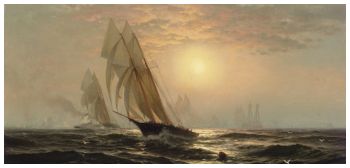 VICTORY OF THE MADELEINE.
VICTORY OF THE MADELEINE.Copyright © The New York Times - Published: August 13, 1876
Inasmuch as the contest of yesterday between the Madeleine and the Countess of Dufferin was the outside or ocean race, it had been decided that the steam-boat Gladwish would leave the battery at 7:30.
 When early starts are mentioned, it is useless to insist too rigorously on punctuality, and so it was a little late when the boat left her moorings. She then steamed out into a thick fog - one of those summer encumbrances that will accommodatingly remove themselves, if only time is allowed them. Blowing her foghorn, and feeling her way through the shipping in the harbor, she reached Stapleton in duo time, and was made fast to the moorings at the club-house. Here matters were very different from the previous day. No breath of air was stirring, and the fog broaden heavily on the water. Long Island was enveloped in it, it crept down the slopes of Staten Island, and the yachts at their moorings loomed up indistinctly. A few times the sun made a feeble attempt to break through the haze, but the gloom would not be dispelled so easily. After patient waiting, however, the time came. A ripple played over the surface of the water, a light breeze came in from south-south-east, and the fog lifted before it. In a few minutes the vapor rolled back from the crest of Staten Island, the opposite shore came out fresh from the heart of the mist, and the disenthralled sun shone out lustrously. No time was lost in taking advantage of the propitious moment. The Gladwish left her moorings, and with as much expedition as possible, hawsers were attached to the Countess and the Madeleine and they were under tow for Sandy Hook. The America came down in tow at little later, and the Wanderer was in waiting at the Hook. Beyond this the yachts were without companionship, but later in the day the Hopkins, Fisher, and Cyclops and the revenue cutter Grant accompanied them. Just outside the Hook they were cast off from the steam-boat, and their sails were run up with all possible dispatch.
When early starts are mentioned, it is useless to insist too rigorously on punctuality, and so it was a little late when the boat left her moorings. She then steamed out into a thick fog - one of those summer encumbrances that will accommodatingly remove themselves, if only time is allowed them. Blowing her foghorn, and feeling her way through the shipping in the harbor, she reached Stapleton in duo time, and was made fast to the moorings at the club-house. Here matters were very different from the previous day. No breath of air was stirring, and the fog broaden heavily on the water. Long Island was enveloped in it, it crept down the slopes of Staten Island, and the yachts at their moorings loomed up indistinctly. A few times the sun made a feeble attempt to break through the haze, but the gloom would not be dispelled so easily. After patient waiting, however, the time came. A ripple played over the surface of the water, a light breeze came in from south-south-east, and the fog lifted before it. In a few minutes the vapor rolled back from the crest of Staten Island, the opposite shore came out fresh from the heart of the mist, and the disenthralled sun shone out lustrously. No time was lost in taking advantage of the propitious moment. The Gladwish left her moorings, and with as much expedition as possible, hawsers were attached to the Countess and the Madeleine and they were under tow for Sandy Hook. The America came down in tow at little later, and the Wanderer was in waiting at the Hook. Beyond this the yachts were without companionship, but later in the day the Hopkins, Fisher, and Cyclops and the revenue cutter Grant accompanied them. Just outside the Hook they were cast off from the steam-boat, and their sails were run up with all possible dispatch.
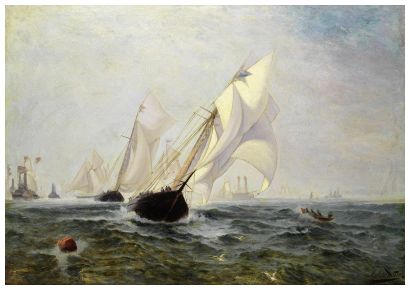 There was some promise in the day, but it inclined altogether in favor of the Madeleine. A pleasant sailing breeze was the heaviest weather that could possibly be anticipated, and for the condition of the water there was not the faintest suggestion of a white-cap. Summer sailing on summer seas was certain, but there was no possible hope of any severe tests like those which tried some of our best craft in the Fall of last year. Buffeting teeming seas, dashing through salt sleet and careening under the influence of the fierce, piping gale were not of course to be thought of. Yet the absence of these rougher elements need in no way detract from the victory of the Madeleine, for it is well known that she can at least stand plenty of wind if she is not specially in love with a rough seaway, while there is nothing yet to show that the Countess is much addicted to either, although the presumption from her seeming strength is that she could stand some rough usage.
There was some promise in the day, but it inclined altogether in favor of the Madeleine. A pleasant sailing breeze was the heaviest weather that could possibly be anticipated, and for the condition of the water there was not the faintest suggestion of a white-cap. Summer sailing on summer seas was certain, but there was no possible hope of any severe tests like those which tried some of our best craft in the Fall of last year. Buffeting teeming seas, dashing through salt sleet and careening under the influence of the fierce, piping gale were not of course to be thought of. Yet the absence of these rougher elements need in no way detract from the victory of the Madeleine, for it is well known that she can at least stand plenty of wind if she is not specially in love with a rough seaway, while there is nothing yet to show that the Countess is much addicted to either, although the presumption from her seeming strength is that she could stand some rough usage.
The Gladwish lost no time in getting into position opposite No.5 buoy, from which the start was made, and in proper time the necessary signals were given. The course was twenty miles to windward, or, in other words, south-south-east and return; but the wind canting a little further to the south the yachts had not exactly a dead beat, but, instead, what is understood in nautical parlance as a long leg and a short one, with a couple of lesser lacks.
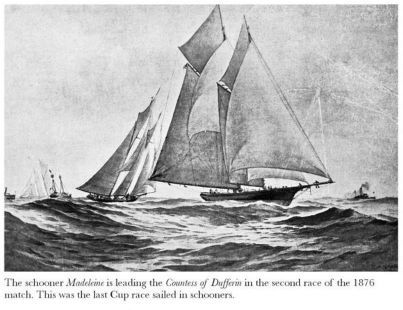 In the start on the inside race there was only some thirty-six seconds between the competitors, and in this instance the difference was reduced to thirty-four seconds. Again the Madeleine crossed first at 12:17:24, followed by the Countess at 12:17:58. The America and Wanderer started after them at 12:22:09 and 12:23:41 respectively. So closes start was entirely satisfactory but the racing yachts had hardly well cleaned the line when the Madeleine began to glide forward in her easy but dangerous fashion. The Countess did not catch way so easily, and for a few minutes she lagged perceptibly behind.
In the start on the inside race there was only some thirty-six seconds between the competitors, and in this instance the difference was reduced to thirty-four seconds. Again the Madeleine crossed first at 12:17:24, followed by the Countess at 12:17:58. The America and Wanderer started after them at 12:22:09 and 12:23:41 respectively. So closes start was entirely satisfactory but the racing yachts had hardly well cleaned the line when the Madeleine began to glide forward in her easy but dangerous fashion. The Countess did not catch way so easily, and for a few minutes she lagged perceptibly behind.
Once outside the point of the Hook they caught a little more of the breeze, and the Countess forged gradually to windward, and this in spite of her jib-topsail. Both were heading about south-east, with the America and Wanderer following after them, the latter at good deal to leeward. The steamboat Gladwisb remained at buoy No.5 for some time, and looking from her deck the diminishing hull of the Madeleine showed that she was gaining rapidly, although she did not hold so good a windward position as the Countess. Up into the wind as closely as possible was evidently the programme of the latter, and she carried it out for a time to some purpose, but the actual headway which she made was not correspondingly advantageous.
 It was clearly another Madeleine day so far, but there were some indications of a. freshening wind. At present, however, it was only a soft breeze, with the warm breath of the south in it. Then the surface of the broad ocean was barely rippled, the waters had just motion enough to glance and sparkle in the sunlight, and it was, in truth, Summer from verge to verge. There was not a speck in the zenith, but all, along the horizon, except in one open space to the south, the bright fleecy clouds were spread like an irregular fringe. The ocean steamers went by, driving through the calm waters with strong, vigorous pulsations, and saluting the yachts as they passed. By contrast, there was a sense of loneliness in the race of yesterday. Instead of a fleet of yachts, as in the previous day, only the white sails of four were visible, the two racing yachts and the attendant America and Wanderer. Both of these, were a good deal to leeward, the America being especially so, while the Wanderer lagged a good way behind. Later the America took up a good windward position, and gained a long lead on the Wanderer.
It was clearly another Madeleine day so far, but there were some indications of a. freshening wind. At present, however, it was only a soft breeze, with the warm breath of the south in it. Then the surface of the broad ocean was barely rippled, the waters had just motion enough to glance and sparkle in the sunlight, and it was, in truth, Summer from verge to verge. There was not a speck in the zenith, but all, along the horizon, except in one open space to the south, the bright fleecy clouds were spread like an irregular fringe. The ocean steamers went by, driving through the calm waters with strong, vigorous pulsations, and saluting the yachts as they passed. By contrast, there was a sense of loneliness in the race of yesterday. Instead of a fleet of yachts, as in the previous day, only the white sails of four were visible, the two racing yachts and the attendant America and Wanderer. Both of these, were a good deal to leeward, the America being especially so, while the Wanderer lagged a good way behind. Later the America took up a good windward position, and gained a long lead on the Wanderer.
Meanwhile the two racing yachts held persistently on the tack in which they started, the Madeleine, however, pointing up better to windward. More and more indistinct they became in the distance; now hull down, and then the sails becoming as mere specks on the horizon. It could be seen, however, that the Madeleine was every moment bettering her position increasing her lead, and forging to windward, while the Countess was making leeway badly. Thus they continued on their course till it became positively monotonous. Would they ever change that interminable reach?
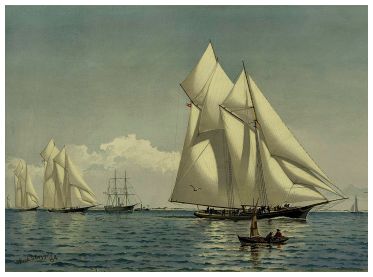 At length the answer came. The Madeleine’s sails suddenly presented a lighter front, and it was seen that she had gone into stays. This was at 3:19. A few minutes later the Countess also tacked, and the two yachts bore in the direction of the steam-boat, which had new accomplished some eighteen miles of the distance to windward. The America and Wanderer, which, although not in the race, were practically raking the part of competitors, pursued different tactics. They went about before they had made nearly so long reach as the others, and in the case of the America at all events with decided advantage. Having steamed the necessary twenty miles the Gladwisb anchored a buoy, and stood by it waiting for the yachts to round. They came along out of the distance, gradually growing more distinct. The sails of the Madeleine showed most prominently, and by and by her hull began to appear above the water level. Next the hull of the America came into view, but on the Gladwish it seemed doubtful whether she held a better position than the Countess, for the latter appeared to be better up to windward. This was a fallacy, however, as appeared when the yachts came nearer. Once fairly in view, the position of the craft was more readily discernible. The lead of the Madeleine was undisturbed and undisputed so far as the Countess was concerned, but the America, without at all operating to her detriment, was crossing her closely.
At length the answer came. The Madeleine’s sails suddenly presented a lighter front, and it was seen that she had gone into stays. This was at 3:19. A few minutes later the Countess also tacked, and the two yachts bore in the direction of the steam-boat, which had new accomplished some eighteen miles of the distance to windward. The America and Wanderer, which, although not in the race, were practically raking the part of competitors, pursued different tactics. They went about before they had made nearly so long reach as the others, and in the case of the America at all events with decided advantage. Having steamed the necessary twenty miles the Gladwisb anchored a buoy, and stood by it waiting for the yachts to round. They came along out of the distance, gradually growing more distinct. The sails of the Madeleine showed most prominently, and by and by her hull began to appear above the water level. Next the hull of the America came into view, but on the Gladwish it seemed doubtful whether she held a better position than the Countess, for the latter appeared to be better up to windward. This was a fallacy, however, as appeared when the yachts came nearer. Once fairly in view, the position of the craft was more readily discernible. The lead of the Madeleine was undisturbed and undisputed so far as the Countess was concerned, but the America, without at all operating to her detriment, was crossing her closely.
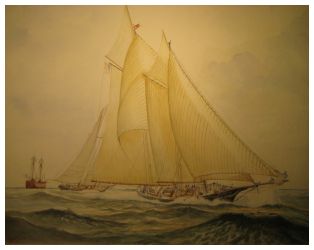 The Madeleine next went about at 4:42, and again went into stays at 4:55, with the view of weathering the buoy and speeding for home. In making this tack she essayed to set her fore-club topsail in the some expeditious style as on the occasion of the inside race, but was less successful in her attempt. The buoy was, however turned in the same splendid style. She came up under rapid way, went round close by and ran up her balloon sails with marvelous celerity. The turn was made at 5:01:52 and the handsome yacht was speeding for home with her immense spread of canvas drawing, although the wind was not particularly brisk. It was 5:13:41 before the Countess rounded, but the America, the performance of which can hardly be omitted, went round at 5:04:53, or three minutes and one second later than the Madeleine. The Wanderer, which had been left at long distance behind did not turn the buoy, but headed for the Hook, running abreast the Madeleine.
The Madeleine next went about at 4:42, and again went into stays at 4:55, with the view of weathering the buoy and speeding for home. In making this tack she essayed to set her fore-club topsail in the some expeditious style as on the occasion of the inside race, but was less successful in her attempt. The buoy was, however turned in the same splendid style. She came up under rapid way, went round close by and ran up her balloon sails with marvelous celerity. The turn was made at 5:01:52 and the handsome yacht was speeding for home with her immense spread of canvas drawing, although the wind was not particularly brisk. It was 5:13:41 before the Countess rounded, but the America, the performance of which can hardly be omitted, went round at 5:04:53, or three minutes and one second later than the Madeleine. The Wanderer, which had been left at long distance behind did not turn the buoy, but headed for the Hook, running abreast the Madeleine.
There was no special feature in the run home, except that the wind hauled to the westward to some extent. The yachts were at lames winged out, but the sum of all their manoeuvres was that the Madeleine still further increased her lead. At 7:37:11 she passed between the Gladwish and No. 5 buoy, so to speak, a laurelled victor. The nautical congratulations from all the steam-boats were vociferous and prolonged, and the Madeleine answered with hearty cheers and with an abundant display of fire-works. The Countess loomed up through the darkness nearly half an hour later, passing the buoy half an hour later, passing the buoy at 8:03:58, but the America had arrived previously at 7:49.
The actual and corrected time of the Madeleine and Countess is as follows:

 The Madeleine thus beats the Countess by 26m. 13s. actual, and 27m. 14s. corrected time. The performance of the America, which is, of course, merely a side question, is also better by 19m. 9s.
The Madeleine thus beats the Countess by 26m. 13s. actual, and 27m. 14s. corrected time. The performance of the America, which is, of course, merely a side question, is also better by 19m. 9s.
The Madeleine was taken in tow by the Grant and brought down to Stapleton, where there w-re, of course, more congratulations. Her victory is complete and beyond cavil, the cup remains in possession of the New-York Yacht Club, and the necessity for a third race is obviated.
